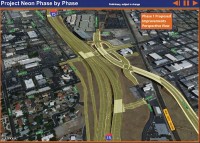
NDOT v. Eighth Jud. Dist. Ct. (Nev. Supreme Ct. – June 25, 2015)
The issues is whether the district court erred by determining that Nevada’s Department of Transportation (NDOT) owed just compensation for taking Ad America’s property in conjunction with Project Neon, a freeway improvement plan, based on NDOT’s and the City of Las Vegas’ precondemnation activities. Specifically, did a taking occur under either the United States or Nevada Constitutions because NDOT publicly disclosed its plan to acquire Ad America’s property to comply with federal law, the City independently acquired property that was previously a part of Project Neon, and the City rendered land-use application decisions conditioned on coordination with NDOT for purposes of Project Neon.
Project Neon
NDOT is the lead agency for Project Neon, a six-phase, 20- to 25-year freeway improvement project for the Interstate Highway 15 (I-15) corridor between Sahara Avenue and the U.S. Route 95/I-15 interchange in Las Vegas. With an estimated cost of between $1.3 and $1.8 billion dollars, the completion of Project Neon depends primarily on funding from the Federal Highway Association (FHWA). To procure this funding, NDOT complied with the National Environmental Policy Act (NEPA) by performing an environmental assessment of Project Neon between 2003 and 2009. NEPA required NDOT to publicly release all reasonable development alternatives it was considering for public comment. Each of these alternatives included the commercial rental property owned by Ad America.
Based on the results of the environmental assessment, NEPA also required NDOT to complete an environmental impact statement (EIS). In 2011, after the approval of the EIS, FHWA allocated $203 million to NDOT for Phase 1 of Project Neon. Notably, at that time, NDOT did not anticipate acquiring Ad America’s property for another 17 years during Phase 5, assuming funding was available.
To reduce the impacts associated with Project Neon, NDOT coordinated efforts with the City of Las Vegas and other agencies. Anticipating the development of an arterial improvement (the MLK Connector) that was no longer a part of Project Neon, the City amended its Master Plan to allow for certain road widening and, on October 24, 2007, purchased a tract of land from a private party. Additionally, the City approved 19 land-use applications for development rights of properties in proximity to Project Neon.
Ad America
Ad America acquired its property between 2004 and 2005, planning to redevelop existing business space into higher-end commercial offices with multilevel parking. To that end, Ad America hired a surveyor and architect, the latter having drafted a preliminary design. Ad America then retained a political consultant to obtain necessary development permits. After speaking with members of the City Planning Department and one City Council member, the consultant opined that there was a de facto moratorium on development in the path of Project Neon. Based on this opinion, Ad America chose not to submit development applications for its property.
In October 2007, Ad America began informing its tenants that its property would be acquired for Project Neon. Although Ad America’s net rental income remained steady from 2007 to 2010, it decreased by approximately 37 percent in 2011. Ad America had not had its property appraised or attempted to sell it. As of August 2012, Ad America could no longer meet its mortgage commitments.
